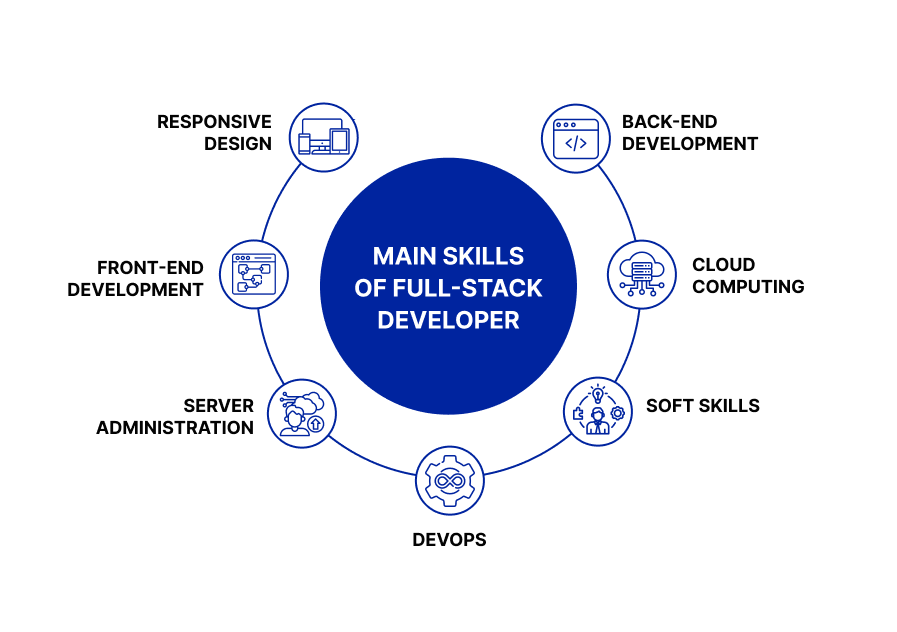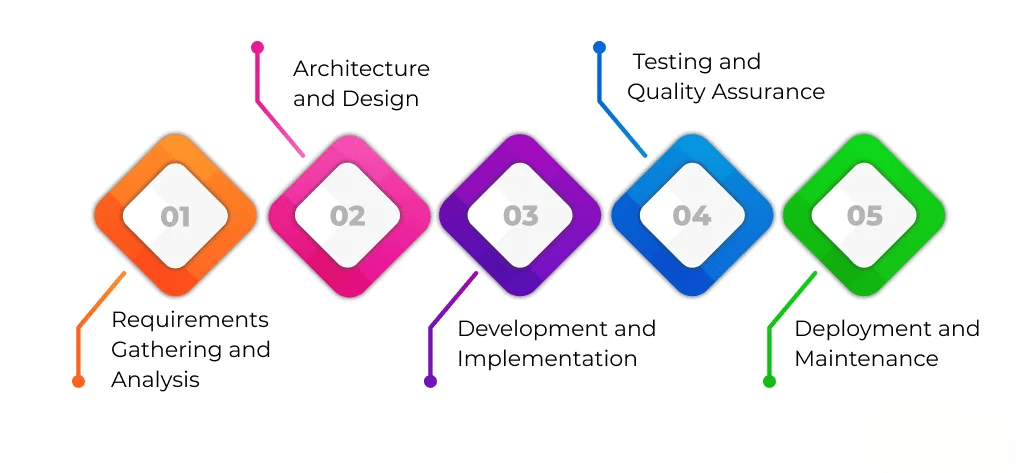
- Introduction to Full Stack Web Development in 2025
- Front-End Development Skills for Full-Stack Developers
- Back-End Development Skills for Full Stack Developers
- Databases and Data Management
- Version Control and Collaboration Tools
- Deployment and DevOps for Full Stack Developers
- Essential Development Tools and Practices
- Staying Up-to-Date with Full Stack Development Trends
- Conclusion
Introduction to Full Stack Web Development in 2025
In 2025, full-stack web development will continue to be one of the most in-demand skills in the tech industry. Full-stack developers are versatile professionals who can handle both the front-end and back-end of a web application. They are responsible for the complete flow of a web app, from the user interface (UI) to the server-side architecture, data storage, and everything in between. Full stack development in 2025 goes beyond the traditional understanding of front-end and back-end development. It now encompasses modern frameworks, cloud computing, microservices, APIs, and the adoption of DevOps practices for continuous integration and delivery. The skill set required for full-stack developers has expanded to include traditional web technologies and the ability to manage cloud infrastructure and databases. To stay competitive and efficient, developers should explore Web Designing & Development Courses that cover these crucial topics. These courses will help you build and deploy highly scalable applications. This roadmap explores the key skills and tools full-stack developers must master in 2025 to stay competitive and efficient in an ever-evolving tech landscape.
Front-End Development Skills for Full Stack Developers
Front-end development is the client-facing part of a web application. It involves everything the user interacts with directly buttons, images, text, forms, and other interactive elements. For a full-stack developer, mastering front-end technologies is essential to building modern, responsive, and engaging user interfaces.
- a. HTML/CSS: HTML (Hypertext Markup Language) and CSS (Cascading Style Sheets) form the foundation of front-end development. In 2025, developers must have an in-depth understanding of HTML5 semantic elements and CSS Grid/Flexbox for layout design.
- b. JavaScript: JavaScript will remain the core language for web development in 2025. Full-stack developers need to master JavaScript’s latest features, such as async/await, destructuring, and spread operators, and understand how to work with closures, scopes, and promises.
- c. Modern JavaScript Frameworks: React, Angular, and Vue.js: React.js is arguably the most popular front-end framework today. It’s known for its component-based architecture and robust ecosystem. Developers often implement features like tab components in react to organize content efficiently and improve user experience. Vue.js is gaining popularity due to its simplicity and flexibility, while Angular, though more opinionated, is still a go-to choice for large enterprise applications. Understanding one or more of these frameworks is critical. Developers should also know how to manage state, handle routing, and integrate with APIs as part of their front-end skill set.
- d. CSS Frameworks and Preprocessors: In 2025, it’s common to use CSS frameworks like Bootstrap, Tailwind CSS, or Material-UI to speed up development. CSS preprocessors like Sass or LESS are also commonly used to manage complex stylesheets, allowing for variables, nesting, and reusable functions.
- e. Responsive Design and Mobile-First Approach: With mobile traffic dominating web traffic, full-stack developers must adopt a mobile-first approach when designing web interfaces. Mastering responsive design techniques and tools like media queries ensures a seamless user experience across devices.

Back-End Development Skills for Full Stack Developers
Back-end development focuses on everything that happens behind the scenes of a web application, such as data processing, database management, and implementing business logic. For full-stack developers, having expertise in both front-end and back-end technologies is essential. On the front-end side, understanding frameworks like React and state management libraries such as React Redux is equally important. A strong command of at least one server-side programming language is a must. In 2025, common choices include JavaScript with Node.js, which allows developers to use JavaScript on both the client and server sides; Python, favored for its simplicity and supported by frameworks like Django and Flask; Ruby, which continues to be effective through Ruby on Rails for rapid development; Java, particularly strong in enterprise settings with Spring Boot and Java EE; and Go (Golang), known for its speed and efficiency in microservices architectures. API development and integration also play a vital role in back-end development. Full-stack developers must be skilled in creating RESTful APIs and using GraphQL for advanced data queries, along with integrating third-party services such as payment gateways and social media platforms. Security is another critical component developers need to implement robust authentication and authorization systems using technologies like OAuth, JWT (JSON Web Tokens), and Single Sign-On (SSO). As modern applications grow in complexity, microservices architecture is becoming increasingly standard. This approach breaks applications into smaller, independently deployable services, which enhances scalability and maintainability. A competent full-stack developer must understand how to design, deploy, and manage these microservices effectively.
Databases and Data Management
Full-stack developers need to be proficient in managing databases and working with data. In 2025, the choice between SQL and NoSQL databases will depend on the project needs, data structure, and scalability requirements.
- a. Relational Databases (SQL): Traditional SQL databases like MySQL, PostgreSQL, and Microsoft SQL Server are still widely used in full-stack development. Full-stack developers must be able to design relational databases, write complex SQL queries, and understand normalization and indexing.
- b. NoSQL Databases: NoSQL databases like MongoDB, CouchDB, and Cassandra are increasingly being used for applications with unstructured data, scalability needs, and real-time applications. Many modern applications must know how to work with document-based and key-value databases. Developers looking to highlight these skills should ensure they are well-represented in a Full Stack Developer Resume.
- ORM (Object-Relational Mapping): In 2025, developers will often use ORM libraries to interface with databases easily. Tools like Sequelize (for Node.js), Django ORM (for Python), and ActiveRecord (for Ruby) abstract SQL queries allow developers to interact with databases using the same programming language as their application.
- Git Basics: Full-stack developers must master Git’s basic commands, such as clone, commit, push, pull, and branch. They must also understand how to resolve merge conflicts and navigate different branches.
- GitHub and GitLab for Collaboration: Platforms like GitHub and GitLab offer repositories, issue tracking, pull requests, and collaboration features, enabling developers to work together efficiently. Knowing how to manage code reviews, versioning, and continuous integration (CI) pipelines on these platforms is key for professional development.
- Text Editors and IDEs: Using the right development environment is crucial for productivity. VS Code, Sublime Text, and JetBrains’ WebStorm are popular for full-stack developers due to their extensibility and support for various languages and frameworks.
- Task Runners and Build Tools: Task runners like Gulp and Webpack and package managers like npm and Yarn help manage dependencies, automate tasks, and bundle code for deployment. Full-stack developers should understand how to configure and use these tools in their workflows.
- Testing Frameworks: Testing is an essential part of building robust web applications. To ensure application quality, full-stack developers must understand both front-end and back-end testing using tools like Jest, Mocha, Cypress, and Selenium.
Excited to Obtaining Your web developer Certificate? View The web developer course Offered By ACTE Right Now!
Version Control and Collaboration Tools
Version control systems like Git are essential for every full-stack developer. They enable them to track code changes, collaborate with teams, and manage deployments. Additionally, resources like Web Developer Certification can strengthen foundational skills and validate expertise. Collaboration platforms like GitHub, GitLab, or Bitbucket are critical for effective teamwork.
Interested in Pursuing Web Developer Master’s Program? Enroll For Web developer course Today!
Deployment and DevOps for Full Stack Developers
Deployment is the final step in the development lifecycle, and in 2025, full-stack developers must be well-versed in DevOps practices to streamline and automate this process. Understanding the deployment pipeline and integrating automation tools are essential for faster, more efficient workflows. One key aspect is containerization, with Docker being widely used to package applications, making them easier to deploy, scale, and manage. Full-stack developers should also be familiar with Kubernetes for container orchestration, particularly when working with microservices or cloud-native environments. Another critical area is CI/CD (Continuous Integration/Continuous Deployment), where tools like Jenkins, GitHub Actions, and CircleCI enable automated testing and deployment, improving collaboration and accelerating development cycles. Proficiency in cloud services such as AWS, Azure, or Google Cloud is also important, as most modern applications are deployed on cloud platforms. Additionally, serverless architecture is gaining popularity, allowing developers to focus on writing code without managing server infrastructure. Services like AWS Lambda, Google Cloud Functions, and Azure Functions support this serverless approach, enabling greater scalability and efficiency. For client-side polish, developers may also benefit from Mastering CSS Tooltips to enhance user interface interactions.

Essential Development Tools and Practices
Beyond coding languages and frameworks, full-stack developers must master various tools and practices to work effectively.
Staying Up-to-Date with Full Stack Development Trends
The tech landscape is constantly evolving. To remain competitive in 2025, full-stack developers must stay informed about the latest trends and advancements.
a. WebAssembly (WASM) WebAssembly is revolutionizing web development by allowing developers to run code (e.g., C, C++, Rust) in the browser at near-native speeds. Full-stack developers should explore how WebAssembly can improve performance and enable new application use cases.
b. GraphQL GraphQL is becoming more popular as an alternative to REST APIs. It offers more flexibility in data fetching and reduces the amount of data transferred between the client and server. Understanding how to build and interact with GraphQL APIs is becoming essential, especially as the Scope of Web Development continues to expand and evolve in response to user demands and technology trends.
c. Artificial Intelligence and Machine Learning Integrating AI and ML models into web applications is becoming a significant trend. To enhance their applications, full-stack developers should learn how to use machine learning libraries or access AI services through APIs.
d. Progressive Web Apps (PWAs) PWAs combine the best features of mobile and web apps. Full-stackFull-stack developers must understand how to build and deploy PWAs, focusing on offline capabilities, service workers, and push notifications.
Conclusion
Becoming a full-stack developer in 2025 involves gaining expertise across both front-end and back-end technologies, making it one of the most versatile and in-demand roles in tech. To succeed, a full-stack developer must master core web languages like HTML, CSS, and JavaScript, along with modern front-end frameworks such as React or Vue.js. On the back end, knowledge of Node.js, Python, or other server-side languages is essential, along with understanding how to work with databases like MongoDB or PostgreSQL. Familiarity with version control systems like Git, CI/CD pipelines, and cloud deployment tools is also necessary for delivering production-ready applications. As the tech landscape constantly evolves, staying current with new trends, tools, and best practices is key. Resources like Web Designing Training can provide valuable foundational knowledge that supports full-stack learning. By following a structured learning roadmap and engaging in real-world projects, aspiring developers can build the practical skills needed to thrive as full-stack professionals. The role demands adaptability, a strong problem-solving mindset, and continuous learning.

